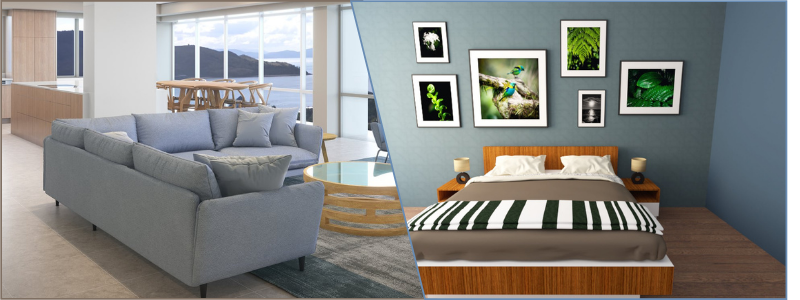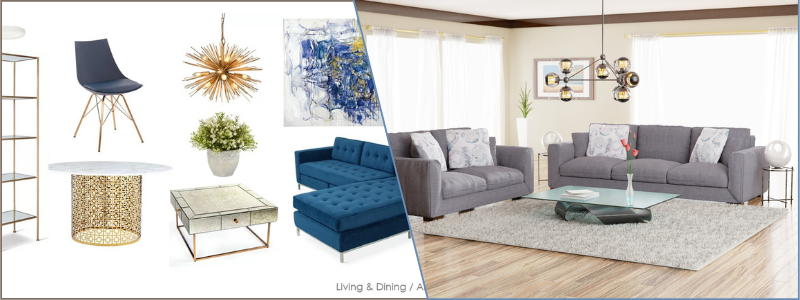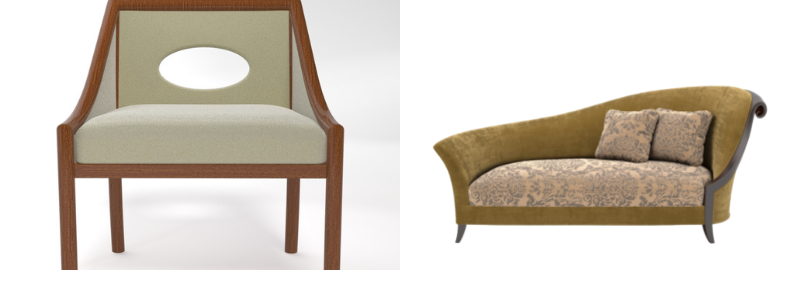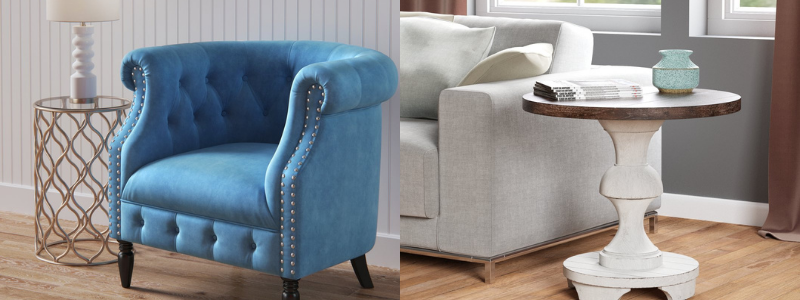This article will share how 3D prototyping helps furniture businesses with new product lines. 3D prototypes have become so advanced that they can now make anything and everything you can imagine, from the most miniature devices to entire residential buildings. For the past few years, the world has witnessed how 3D prototyping and 3D printing have revolutionized various industries. It is almost like there is nothing you cannot get printed right now. And to make things even more exciting, 3D technology has also conquered the furniture industry. From decorative hardware to lamps, tables, and chairs, these are being printed these days, marking a significant change to how companies manufacture their products while providing consumers with more exciting options.
Table of contents
- Design furniture components quickly with 3D prototyping
- Boost furniture sales via eCommerce with 3D prototyping
- 3D prototyping revolutionizes the design process
- Benefits await consumers thanks to 3D prototyping
- 3D prototyping offers more cost-effective logistics
- 3D prototyping follows industry compliances
- Full-size prototyping and production made possible.
- Join furniture panels with 3D prototyping
- Leverage 3D prototyping for sales and marketing
- 3D prototyping is a breakthrough in manufacturing
- 3D prototyping allows furniture businesses to produce replacement tools and parts on demand
- Test the market better with 3D prototyping
- 3D prototyping offers more value for people with disabilities
- 3D prototyping produces furniture prototypes in bulk
- 3D prototyping is more affordable than traditional methods of prototyping
- How Cad Crowd can help
RELATED: 6 Ways you can use 3D printing services to create a new prototype design
3D prototyping is gaining momentum all over the vast landscape of furniture manufacturing. Its ability to generate virtual products, allow mass customization, and improve costs has spurred the acceptance of both manufacturers and customers. Here are some of the ways that 3D prototyping helps furniture businesses with new product lines:
Design furniture components quickly with 3D prototyping
Many contemporary functional furniture items, such as desktop lighting, adjustable standing desks, and office chairs, are made up of numerous smaller components that will be assembled to form the final product. Every component of an item, like lamp bases, armrests, and seat adjusters, has its basic requirements to function correctly.
But the distinct features of a specific furniture product will make up the aesthetic form, ergonomic design, and structural performance. This is where furniture businesses can use 3D printing to help with these particular design features.
RELATED: How to get the best 3D rendering services for furniture design

3D prototyping allows the initial parts to be modeled, printed and tested right away for ergonomic function and fit. One of the key advantages of 3D printing is its ability to produce several iterations of an idea at a fraction of the cost. When the actual components are readily available, the designer can evaluate the primary aspects of ergonomic design, such as the viewing angles or the particular grip feel.
The designer can make rapid optimizations to the invention in a snap. The ability to interact personally with the physical hardware during the early stages of the design process, instead of relying on drawings and models alone, can empower designers to make more informed and confident decisions.
RELATED: How to turn your idea into a new product prototype
Suitable quality materials must be considered if the design calls for the creation of high dimensional and accurate components with outstanding mechanical properties and surface finish. It is also possible to use 3D models to produce low-volume molds for lower volume production runs and higher-quality prototypes.
Boost furniture sales via eCommerce with 3D prototyping
The eCommerce industry has been enjoying the same level of success as brick-and-mortar stores worldwide. Now more than ever, many people are opting to shop for furniture items online. To make the most of this, manufacturers can leverage the power of highly realistic 3D product rendering and create renders from different angles. Online shoppers can easily zoom in and rotate an image for more detailed scrutiny and inspection of the product. This can significantly boost your product’s aesthetic appeal and help customers visualize it better.
RELATED: How does product prototyping with 3D modeling help grow sales and save R&D money?

3D prototyping revolutionizes the design process
One specific area of the furniture industry that has traditionally required substantial financial investment and significant time in the design process. There is a need to produce prototypes, test models, and rework pieces to form the final product.
3D printing technology can streamline, simplify, and reduce the costs of designing furniture. The ability to create lightweight prototypes of furniture items quickly and inexpensively through 3D printing allows 3D designers to test all their creations more thoroughly and improve the beneficial features that the finished article has to offer.
A quickly increasing number of furniture businesses are experimenting with 3D prototyping, and they have been enjoying creative results. With lower expenses for design and production, 3D printing allows companies to craft furniture pieces that are functional and beautiful at the same time.
RELATED: How 3D modeling can cut costs in the furniture market
Benefits await consumers thanks to 3D prototyping
It has been historically proven that custom-designed furniture pieces are cost-prohibitive due to all the costs required on the business end. However, some of these burdens are eliminated with printed furniture. This technology has made it easier to design prototypes, allowing customers to enjoy the finished pieces immediately. They are given a chance to pick their preferred styles, colors, and other options for customization without adding extra costs to the printing process.
Although 3D prototyping is expected to change many areas of today’s furniture industry, this will not completely replace traditional upholstery or manufacturing. Those who want more classic designs or items made of exotic materials and woods won’t likely start to favor the very contemporary furniture style produced through 3D printing.
On the other hand, consumers who dream of furniture items that look like minimalist pieces, custom artwork, and trendy Pinterest boards will surely fall in love with the unique beauty of 3D-printed furniture. Aside from having a more comprehensive range of designs available to choose from and acquiring custom pieces efficiently, 3D printed furniture is also lighter on the wallet than traditionally manufactured pieces. While a custom table can easily cost several thousand dollars, getting a printed one will only cost a few hundred or less. And once again, the customer can also receive the furniture piece faster.
RELATED: 3D product renderings: myths on outsourcing your company’s project design
This impressive speed can change the world of furniture shopping, and consumers are now starting to realize it. Sooner or later, customers can go to the closest locations and get any table, chair, or fixture 3D-printed right on the spot. Just imagine having the ability to view a furniture piece online, get it printed, and pick it up all within the same day. This possibility is genuine, and retailers and shoppers can expect this to turn into reality in years.

3D prototyping offers more cost-effective logistics
3D modeling has simplified the process of managing modular furniture stocks since it eliminates the need for you to fill up the stockroom with all physical designs. Instead, you can have the plan refabricated on the production line if there are signs of rising demand. As expected, it is more cost-effective to store all your designs on your computer’s hard drive instead of holding a mountain of physical furniture items in a warehouse.
3D prototyping follows industry compliances
To develop top-quality furniture items, it is imperative to adhere to international standards and high precision. However, there is often a deviation from the bars when product design development moves on from designing to manufacturing drawings. With the help of CAD software, it has become possible to create designs digitally with an exceptional level of accuracy. This also allows furniture businesses to predefine specific parameters such as angles, borders, and other elements in their chosen dimensioning system. In addition, it also lets them retain symmetry in the entire product line by simply stipulating the preferred dimensioning system.
RELATED: 3D rendering: 15 reasons to use 3D photorealistic rendering at your furniture company
Full-size prototyping and production made possible.
Thanks to state-of-the-art CAD software and large-scale 3D printers, developing complex functional designs in a completely digitized process chain has become possible. The ability to quickly design and iterate paves the way to explore newer and more intricate shapes. Different design processes and software further aid this as they allow adding features and self-configuring alterations to the models.

Join furniture panels with 3D prototyping
Additive manufacturing has become a more valued tool in creating original furniture items because it’s possible to produce 3D-printed panel joints that can be used for joining flexible or flat plywood panels to form work-surface solutions or creative shelving.
By making distinct custom joints for a specific project, furniture businesses can create modern furniture pieces without using traditional adhesives or fasteners. Relatively tiny joints can also be designed for positioning the panels at the preferred angle. Several copies of every component can also be used for building a complete piece. This form of design can lend itself to open-source furniture. When joints wear out or break over time, it is possible to print new parts using any machine, provided that the models are still accessible.
RELATED: How furniture prototyping gives you an advantage during the manufacturing process
The designs for these kinds of plastic joints can also be produced using injection molding for better mechanical strength. 3D printed parts, however, may already be enough as they are for lower-load and low-volume-bearing furniture pieces.
Leverage 3D prototyping for sales and marketing
To ensure that your clients can understand your entire design, it might be necessary for them to see it from different viewing angles. This is where 3D prototyping works best. You can develop 3D solid models of your furniture products that allow clients to zoom in and rotate to take a closer look at the design before placing an order for its manufacturing.
Customers can also enjoy the model better with the help of virtual reality and even experience and get a feel of the product way before they invest their money and time in it. More and more manufacturers of high-end lifestyle furniture are now using 3D prototyping to create videos of their product catalogs and showcase how their products can enhance a room’s overall visual appeal by rendering the most realistic images of their models.
RELATED: Why product design services use photorealistic rendering for marketing new products
3D prototyping is a breakthrough in manufacturing
Aside from giving designers the ability to manufacture furniture that is simply impossible to produce using traditional techniques, 3D prototyping has also made it more affordable for new businesses to join the furniture industry.
Lower production and design expenditures allow the development of furniture that can be made for consumers right away at a lower cost on both ends of the spectrum. It is a win-win situation for manufacturers, designers, and consumers searching for unique furniture on a tight budget.
Ever since its introduction, the industry of 3D prototyping has been continuously growing every year. This technology allows home goods retailers and furniture businesses to improve their bottom line, significantly reduce the energy and resources wasted, and make the entire production process more efficient. 3D prototyping is not just a cheaper strategy for furniture companies; it is also more sustainable and eco-friendly than traditional furniture-making and product design methods.
RELATED: Top 9 design engineering tips for reducing manufacturing costs on new product designs & prototypes

3D prototyping allows furniture businesses to produce replacement tools and parts on demand
Among the main benefits of 3D prototyping, not just in the furniture industry but also in other sectors, is that it allows on-demand production. Thanks to this, manufacturers can produce smaller replacement parts and tools on request. This saves them from the need to keep the products in constant production and pay storage costs for these products. It is applicable in the furniture market, where more oversized products have critical small parts that constantly wear out and break down.
Test the market better with 3D prototyping
With 3D prototyping, it is possible to generate cheaper furniture designs than actual furniture pieces. Aside from this, no resources will be wasted either. Furniture businesses can harness the power of advanced analytics and effective social media platforms by simply uploading top-quality renders that can reach millions of people all over the globe.
This gives a furniture business a more in-depth insight into how the target market responds to the designs. 3D Furniture designers can develop the most adored designs and roll them out for selling. Customization is one of the first things that customers look for, and it is possible to offer this through 3D prototyping even before the actual creation of the furniture piece.
RELATED: 6 Ways you can use 3D printing services to create a new prototype design
3D prototyping offers more value for people with disabilities
It is all too easy to take a particular design for granted and assume it to be there just for aesthetic purposes. For people with disabilities, however, this can be a significant concern. People with physical or neurological conditions often find it hard to turn ordinary door handles or knobs. Good thing that 3D prototyping projects are now addressing these issues, too.
Customization already helps manufacture better furniture textures and more comfortable chairs. The IKEA brand has taken things even further, as they now allow their shoppers to print add-ons to make their everyday activities more accessible and more superficial. One of their projects promotes brilliant hacks for IKEA products that can be printed and accessible online right away.
Customization also benefits senior citizens as it allows the development of furniture pieces that fit their exact requirements and specifications. 3D prototyping constantly offers new materials, new levels of customization, and new levels of convenience that offer more added value for people who need it most.
3D prototyping produces furniture prototypes in bulk
Even when your furniture business focuses on creating just a single type of furniture, it is still necessary to make many prototypes before launching your final product. There are instances when it may take dozens or even more tries to finally achieve that perfect furniture piece.
RELATED: How 3D modeling can cut costs in the furniture market
You can imagine how nightmarish traditional prototyping can be for industry giants. Companies will waste more materials and resources on making props than selling the actual product itself.3D prototyping is an attractive solution for making designs come to life fast and in bulk. It is even possible to do it with no need to print the prototypes. Future furniture pieces can be showcased by ordering top-notch 3D models, animations, or renders.
3D prototyping is more affordable than traditional methods of prototyping
Furniture design is far from being a cheap process. When the draft phase is over, the product should be tested in the field, which requires a physical representation of sketches. Before the invention of 3D printers, the furniture maker had to develop single-use disposable props to test the design.
Money will vanish into the wind if the initial design fails to work. 3D printing is a more affordable alternative. The toner will not only cost less compared to traditional materials, But with current advances in technology, it is possible to melt the discarded 3D printed prop and set it aside for use later on. Reduced expenses mean more profits for the furniture business in the end.
RELATED: How your company can save money with 3D models
With lower costs of production, limitless design possibilities, and satisfied consumers, it is easy to see why 3D prototyping is now conquering the furniture industry. It is also simple to employ, flexible, affordable, and improves day by day. It isn’t an overstatement to say that 3D prototyping is the future of all forms of manufacturing. Take advantage of this modern technology today to prototype your furniture products.
How Cad Crowd can help
Go over your project idea with us, and we’ll help you get started with one of our skilled professionals. Contact us today and receive a free quote.
